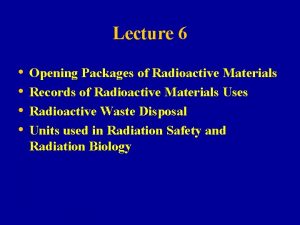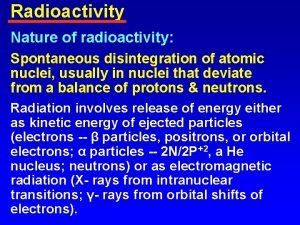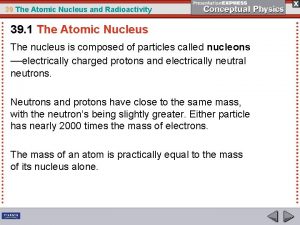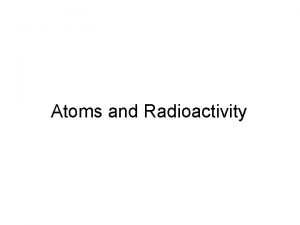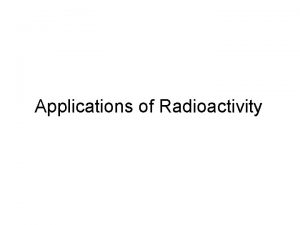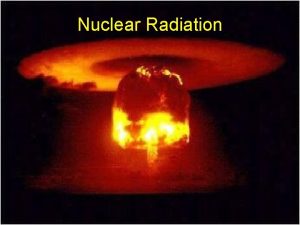Radiation Units 1 Radioactivity Units n Physical Units













- Slides: 13

Radiation Units

1 -Radioactivity Units n Physical Units – Becquerel n Amount of radioactive sample s. t. there is 1 atomic decay per second n Henri Becquerel: discovered radioactivity through experiments with uranium and other radioactive matter – Curie (Ci) n 3. 7*1010 decays per second n Approx. activity of 1 g radium

2 -Exposure units (Roentgen(abbreviated 'R' n The roentgen is a unit for measuring exposure. It is defined only for effect on air. The roentgen is essentially a measure of how many ion pairs are formed in a given volume of air when it is exposed to radiation. Therefore it is not a measure of energy absorbed, or dose. It applies only to gamma and x-rays. It does not relate the amount of exposure to biological effects of radiation in the human body.

n The roentgen describes the amount of xrays or gamma rays to which a target (e. g. , fly, mouse, rat, dog, human, cow, elephant, etc. ) is exposed. The roentgen relates to the ability of x-rays and gamma rays to remove electrons from atoms in one cm 3 of air. 1 R (Roentgen) = 1000 m. R (milli. Roentgen)

3 - Biological Units Rad (Radiation Absorbed Dose) n The rad is a unit for measuring absorbed dose in any material. Absorbed dose results from energy being deposited by the radiation. It is defined for any material. It applies to all types of radiation. It does not take into account the potential effect that different types of radiation have on the body. n

Therefore, it can be used as a measure of energy absorbed by the body, but not as a measure of the relative biological effect (harm or risk) to the body. n 1 rad = 1000 millirad (mrad) n 1 gray= 100 rad n

The radiation absorbed dose is important for describing radiation effects. The absorbed dose relates to how much radiation energy gets put into a given target mass (e. g. , lung, eye, thyroid gland). n The absorbed dose has units of energy divided by mass (e. g. , ergs per gram or joules per kilogram n

Different absorbed doses can arise in different organs or tissue of the body for the same exposure in R. Thus, if a person were exposed to 10 R of gamma rays, the eye, the thyroid, and the lung would have different absorbed doses. Special computer programs can calculate such doses. n Units of absorbed dose often used are the rad and gray (an SI unit). n

The gray unit represents 1 joule of radiation energy put into a kilogram mass. Thus, 1 gray equals 1 joule per kilogram. n The gray and rad apply to all types of ionizing radiation, unlike the roentgen unit, which only applies to x-rays and gamma rays. n

Biological Units Radiation-Protection Units: n Equal doses of different types or energies of radiation cause different amounts of damage to living tissue. For example, 1 Gy of alpha radiation causes about 20 times damage as 1 Gy of x- rays. Therefore the equivalent dose was defined to give an approximate measure of the biological effect of radiation. It is calculated by multiplying the absorbed dose by a weighting factor W R which is different n

Relative Biological Effectiveness (RBE) or weighting factor W R WR X rays, gamma rays, electrons, positrons 1 n Neutrons, protons (10 -100 Ke V) 10 n Neutrons, protons (less than 10 Ke V ) 5 n Alpha particles 20

Law of the rem (introduced here for the first time to help understand its use): n The risk of harm from 1 rem to an organ from one radiation source = the risk of harm from 1 rem to that organ from any other radiation source! n

Question 1 n Enumerate the different radiation units? , their definition and their relationship?
 Units of radioactivity
Units of radioactivity Natural and artificial radioactivity
Natural and artificial radioactivity Natural vs artificial radioactivity
Natural vs artificial radioactivity Becquerel discovery of radioactivity
Becquerel discovery of radioactivity Who discovered radioactivity
Who discovered radioactivity Who discovered uranium
Who discovered uranium Natural and artificial radioactivity
Natural and artificial radioactivity Law of radioactive decay
Law of radioactive decay Radioactivity as spontaneous disintegration
Radioactivity as spontaneous disintegration Mta
Mta Radioactivity
Radioactivity Radioactivity definition geology
Radioactivity definition geology Datación radiométrica
Datación radiométrica Natural radioactivity
Natural radioactivity
